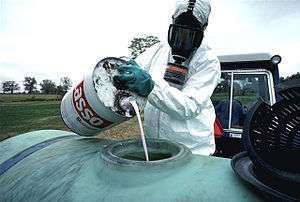Pesticides in Canada
The use of pesticides in Canada is regulated by the Pest Management Regulatory Agency, a division of Health Canada via the Pest Control Products Act to provide effective management of pest infestations when other methods of pest control are not succeeding for the health of the community.[1] Pesticide use is occasionally contentious.
Regulation
The use, manufacture, storage, distribution, application, sale, and labeling of pest control products are regulated at various levels of government (federal, provincial, municipal).
All pest control products undergo a pre-market assessment by the Pest Management Regulatory Agency (PMRA) to ensure the products are safe when used according to use directions, in relation to applicator/consumer, animal, environmental safety. Certain applications also undergo efficacy assessments to ensure the products work. Once it is approved by PMRA, the product is registered for a period of 5 years, after which an administrative renewal application must be submitted.
Individual provinces regulate the application, sale, storage of pest control products in their individual jurisdictions. These are regulated via a system of permits and licenses for business to sell products, for applicators to apply products (including mandatory training), and facilities to store products.
Although limited, municipalities also have certain regulatory controls over the use of certain pest control products in cities.
The ban on cosmetic lawn pesticides started from municipalities regulating their use, which then spread across the province and onwards. In Canada as of December 31, 2010, 171 municipalities including the entire provinces of Quebec and Ontario (representing 79.6% of the population) have now placed restrictions on the cosmetic use of synthetic lawn pesticides as a result of health and environmental concerns.[2] The Ontario provincial government promised on September 24, 2007 to also implement a province-wide ban on the cosmetic use of lawn pesticides, for protecting the public.[3] Medical and environmental groups support such a ban.[4] On April 22, 2008, the Provincial Government of Ontario announced an intention to prohibit, province-wide, the cosmetic use and sale of lawn and garden pesticides.[5] The Ontario province-wide pesticide ban on lawn pesticides came into effect on Earth Day, April 22, 2009. [6] Over 250 products are banned for sale and more than 95 pesticide ingredients are banned for cosmetic uses.[7] The Ontario legislation would also echo Massachusetts law requiring pesticide manufacturers to reduce the toxins they use in production.[8] New Brunswick and Prince Edward Island adopted legislation in 2009 and 2010 respectively, banning just one lawn pesticide - the herbicide 2,4-D. [9] [10]
Issues
Pesticide residue in foods
Effects on biota
For example, in Montague on Prince Edward Island, nine fish kills happened in one year: every fish, snake, and snail was killed in a river called Sutherland's Hole near potato farms from which herbicides, insecticides, and fungicides ran off after heavy rains.[11]
A study showed that exposing tadpoles to endosulfan, an organochloride pesticide at levels that are likely to be found in habitats near fields sprayed with the chemical kills the tadpoles and causes behavioral and growth abnormalities.[12]
Opinion
On April 3, 2008, the Canadian Cancer Society released opinion poll results conducted by Ipsos Reid, which established that a clear majority of residents in the provinces of British Columbia and Saskatchewan want province-wide cosmetic lawn pesticide bans, and that the majority of respondents believe that cosmetic pesticides are a threat to their health.
Lobbying
The Canadian Association of Physicians for the Environment,a non-profitable organization dedicated to environmental issues especially as they relate to human health, have campaigned on the hazards of lawn pesticides.
See also
References
- ↑ "Pesticides and Pest Management". Health Canada. Government of Canada. 2009-08-17. Retrieved 2009-08-22.
- ↑ http://www.flora.org/healthyottawa/BylawList.pdf
- ↑ Latest News
- ↑ http://cela.ca/uploads/f0803f62de5d2a1f673df7aaaca0e77b/ONPesticideBanStatement.pdf
- ↑ "globeandmail.com". The Globe and Mail. Toronto.
- ↑ http://www.ene.gov.on.ca/en/news/2009/030401.php
- ↑ http://www.ene.gov.on.ca/en/land/pesticides/class-pesticides.php
- ↑ Benzie, Robert (April 22, 2008). "Pesticide ban set to grow". The Star. Toronto. Retrieved May 22, 2010.
- ↑ http://www.gnb.ca/cnb/news/env/2009e0865ev.htm
- ↑ http://www.producer.com/2012/02/when-bans-become-banes%E2%80%A9/
- ↑ Toughill K (1999), The summer the rivers died: Toxic runoff from potato farms is poisoning P.E.I. Originally published in Toronto Star Atlantic Canada Bureau. Retrieved on September 17, 2007.
- ↑ Raloff, J (September 5, 1998) Common pesticide clobbers amphibians. Science News, Volume 154, Number 10, Page 150. Retrieved on 2007-10-15.
External links
- Health Canada - Consumer Product Safety: Pesticides and Pest Management
